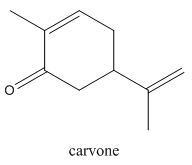
Introduction to General, Organic and Biochemistry
12th Edition
ISBN: 9780357391594
Author: Frederick A. Bettelheim; William H. Brown; Mary K. Campbell
Publisher: Cengage Learning US
expand_more
expand_more
format_list_bulleted
Concept explainers
Question
Chapter 14, Problem 43P
Interpretation Introduction
(a)
Interpretation:
For the following structural formula for the carvone:

The r or s configuration to the single stereocenter in each should be assigned.
Concept Introduction:
Carvone comes under the chemical family known as terpenoids. It is present naturally in several important oils, but is most abundant within the oils from the seeds of dill, spearmint and caraway.
Expert Solution & Answer
Want to see the full answer?
Check out a sample textbook solution
Students have asked these similar questions
ΗΝ,
cyclohexanone
pH 4-5
Draw Enamine
I
I
CH3CH2Br
THF, reflux
H3O+
I
Drawing
Draw Iminium Ion
:0: :0:
Select to Add Arrows
:0:
(CH3)2NH
:0:
■ Select to Add Arrows
:0:
:0:
(CH3)2NH
■ Select to Add Arrows
Draw the product of the following
H
action sequence. Ignore
any inorganic byproducts formed.
1. (CH3CH2)2CuLi, THF
2. CH3Br
Q
Atoms, Bonds
and Rings
H
Charges
ㅁ
Chapter 14 Solutions
Introduction to General, Organic and Biochemistry
Ch. 14.1 - Prob. 14.1QCCh. 14.2 - Problem 15-2 Assign priorities to the groups in...Ch. 14.2 - Problem 15-3 Assign an R or S configuration to the...Ch. 14.3 - Problem 15-4 3-Amino-2-butanol has two...Ch. 14.3 - Prob. 14.5QCCh. 14.3 - Prob. 14.6QCCh. 14 - 15-7 Answer true or false. The cis and trans...Ch. 14 - 15-8 What does the term “chiral” mean? Give an...Ch. 14 - 15-9 What does the term “achiral” mean? Give an...Ch. 14 - 15-10 Define the term “stereoisomer.” Name three...
Ch. 14 - 15-11 In what way are constitutional isomers...Ch. 14 - 15-12 Which of the following objects are chiral...Ch. 14 - Prob. 7PCh. 14 - Prob. 8PCh. 14 - Prob. 9PCh. 14 - Prob. 10PCh. 14 - 15-15 Explain why the carbon of a carbonyl group...Ch. 14 - 15-16 Which of the following compounds contain...Ch. 14 - 15-17 Which of the following compounds contain...Ch. 14 - Prob. 14PCh. 14 - 15-19 Draw the mirror image for each molecule: OH...Ch. 14 - Prob. 16PCh. 14 - 15-21 Answer true or false. For a molecule with...Ch. 14 - Prob. 18PCh. 14 - Prob. 19PCh. 14 - Prob. 20PCh. 14 - Prob. 21PCh. 14 - 15-26 For centuries, Chinese herbal medicine has...Ch. 14 - Prob. 23PCh. 14 - Prob. 24PCh. 14 - Prob. 25PCh. 14 - Prob. 26PCh. 14 - Prob. 27PCh. 14 - Prob. 28PCh. 14 - Prob. 29PCh. 14 - Prob. 30PCh. 14 - 15-35 Following are structural formulas for three...Ch. 14 - Prob. 32PCh. 14 - 15-37 Consider a cyclohexane ring substituted with...Ch. 14 - Prob. 34PCh. 14 - Prob. 35PCh. 14 - Prob. 36PCh. 14 - 15-41 Compound A(C5Hh, is not optically active and...Ch. 14 - Prob. 38PCh. 14 - 15-43 Triamcinolone acetonide, the active...Ch. 14 - 15-44 Consider the structure of the...Ch. 14 - Prob. 41PCh. 14 - 15-46 Consider Lunesta, a nonbenzodiazepine...Ch. 14 - Prob. 43PCh. 14 - Prob. 44P
Knowledge Booster
Learn more about
Need a deep-dive on the concept behind this application? Look no further. Learn more about this topic, chemistry and related others by exploring similar questions and additional content below.Similar questions
- Please help me with this the problem is so confusingarrow_forward14 Question (1 point) Disiamylborane adds to a triple bond to give an alkenylborane. Upon oxidation with OH, H2O2, the alkenylborane will form an enol that tautomerizes to an aldehyde. In the first box below, draw the mechanism arrows for the reaction of disiamylborane with the alkyne, and in the last box draw the structure of the aldehyde. 4th attempt Feedback i > 3rd attempt OH, H2O2 i See Periodic Table See Hintarrow_forwardanswer with mechanisms and steps. handwritten please!arrow_forward
- Hello I need some help with Smartwork. For drawing structure B, I know the correct answer is CH₃B₂, but when I try to type it in, it keeps giving me CH₄BH₃ instead. Do you know how I should write it properly? Should I use a bond or something else?arrow_forwardTrue or false, chemistryarrow_forwardanswer thse questions with mechanisms and steps. handwritten please!arrow_forward
- C app.aktiv.com Draw the product of the following reaction sequence. Ignore any inorganic byproducts formed. H O 1. (CH3CH2)2CuLi, THF 2. CH3Br Drawingarrow_forwardDraw the product of the following reaction sequence. Ignore any inorganic byproducts formed. H O 1. (CH3CH2)2CuLi, THF 2. CHзBr Drawingarrow_forwardSeee the attached imaarrow_forward
arrow_back_ios
SEE MORE QUESTIONS
arrow_forward_ios
Recommended textbooks for you
 Introduction to General, Organic and BiochemistryChemistryISBN:9781285869759Author:Frederick A. Bettelheim, William H. Brown, Mary K. Campbell, Shawn O. Farrell, Omar TorresPublisher:Cengage Learning
Introduction to General, Organic and BiochemistryChemistryISBN:9781285869759Author:Frederick A. Bettelheim, William H. Brown, Mary K. Campbell, Shawn O. Farrell, Omar TorresPublisher:Cengage Learning

Introduction to General, Organic and Biochemistry
Chemistry
ISBN:9781285869759
Author:Frederick A. Bettelheim, William H. Brown, Mary K. Campbell, Shawn O. Farrell, Omar Torres
Publisher:Cengage Learning

Acid-Base Titration | Acids, Bases & Alkalis | Chemistry | FuseSchool; Author: FuseSchool - Global Education;https://www.youtube.com/watch?v=yFqx6_Y6c2M;License: Standard YouTube License, CC-BY